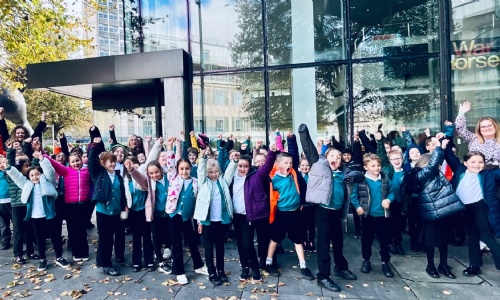Looking Ahead to our Spring Term Music Curriculum: Fostering a love for music through building strong foundations.

As we move towards the spring term at Mayflower Community Academy, our music curriculum continues to foster a love for music while building strong foundations in musical literacy. This term promises a wealth of exciting opportunities for our students across all year groups as they explore new concepts and deepen their understanding of melody, rhythm, and expression through our Kodály-inspired approach.
Year 1: Comparative Concepts
Our youngest learners in Year 1 are embarking on an exploration of fundamental contrasts in music, such as fast and slow, high and low, soft and loud, and long and short. These comparative concepts form the building blocks of musical expression. Through singing, rhythmic chants, and movement games, children will internalize these ideas in a playful, hands-on way. The voice takes center stage this term as the first and most accessible instrument, ensuring that every child develops confidence and aural awareness. By the end of the term, students will transition these skills to classroom percussion, preparing them for their journey into instrumental music-making.
Year 2: Two-Note Chants and Rests
In Year 2, students are diving deeper into pitch relationships with two-note chants focused on so and mi while also discovering the importance of silence through rests. Singing games and body percussion activities will help students internalize these concepts, developing accuracy in pitch and rhythm. This multi-sensory approach ensures they not only recognize but also perform simple melodic and rhythmic patterns with confidence. By the end of the term, children will have laid the groundwork for future melodic and rhythmic fluency.
Year 3: Expanding Solfège and Beamed Semiquavers
Year 3 students are taking their next step in musical literacy by expanding their solfège repertoire with the introduction of re and tackling the complexity of beamed semiquavers (four sounds on one beat). Through rhythmic games and singing exercises, students will learn to decode, perform, and combine these faster rhythms with other familiar note values. Meanwhile, their melodic work will incorporate so, mi, and re, reinforcing pitch relationships and enabling students to navigate more intricate melodic structures with confidence.
Year 4: Advanced Rhythms and Low So
For Year 4, the focus shifts to more advanced rhythmic patterns like ti-ri ti (two semiquavers followed by a quaver) and expanding the solfège range to include low so. This term, students will explore the broader range of the solfège scale, using hand signs and vocal exercises to internalize these intervals. Rhythmically, they’ll engage in practical activities that integrate new patterns with familiar ones, building fluency and creativity. These skills will equip them for more complex musical challenges while enriching their performance abilities.
Year 5: Dotted Rhythms and Fa
Year 5 students are delving into the world of dotted rhythms, focusing on dotted crotchet-quaver patterns, alongside the introduction of fa, the fourth degree of the solfège scale. These new concepts allow for a richer exploration of rhythm and melody. Using rhythm syllables, clapping, and instrumental activities, students will practice performing and recognizing these patterns while singing and playing melodies that incorporate fa. This term’s learning fosters precision and expression, preparing students for increasingly sophisticated repertoire.
Year 6: Sharps and Flats with Si and Fi
In their final spring term, Year 6 students are exploring chromaticism by learning about sharps and flats within the solfège system, focusing on si (raised so) and fi (raised fa). These altered tones provide opportunities to explore new harmonic possibilities and modes. Through vocal exercises, hand signs, and instrumental work, students will experiment with these pitches in ascending and descending patterns, gaining fluency and confidence. By creating and performing their own short melodies using si and fi, students will develop a deeper understanding of chromaticism and prepare for advanced musical challenges ahead.
This term is packed with opportunities for creativity, expression, and growth. By focusing on developmentally appropriate yet progressively challenging concepts, our music curriculum ensures that every child leaves each lesson with a sense of accomplishment and joy. As always, the Kodály philosophy reminds us that the voice is our first instrument, and through singing, movement, and play, our students will continue to build a lifelong connection with music.
The Spring term at Mayflower Community Academy promises to be a vibrant and inspiring journey through the world of music! From exploring exciting new rhythms and melodies to discovering how contrasts and chromatic tones bring music to life, our students will grow in confidence, creativity, and musical fluency. With engaging, hands-on lessons that spark curiosity and joy, this term will have every child singing, clapping, moving, and playing their way to new skills and a deeper love for music. Don’t miss the magic as it unfolds—be sure to follow @madinmayflowermusic on Instagram for updates, highlights, and a behind-the-scenes look at the incredible music-making happening in our classrooms.
